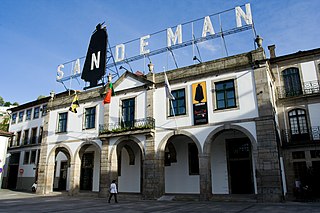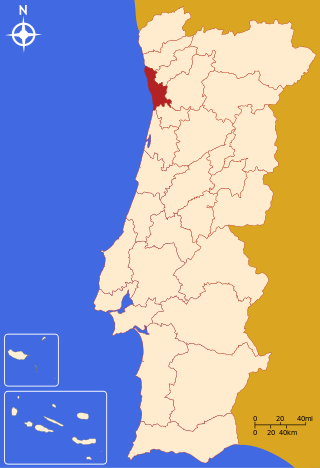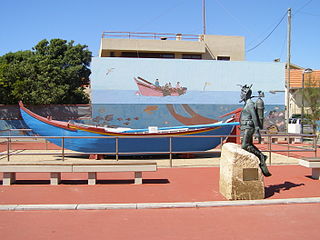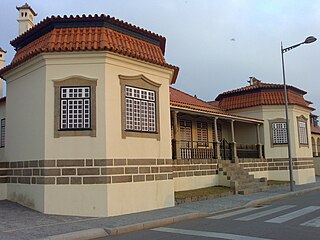
Miramar is a small seaside village near the towns of Gulpilhares and Arcozelo, in the municipality of Vila Nova de Gaia, in the subregion of Greater Porto, Portugal (Grande Porto).

Miramar is a small seaside village near the towns of Gulpilhares and Arcozelo, in the municipality of Vila Nova de Gaia, in the subregion of Greater Porto, Portugal (Grande Porto).
It is an upmarket residential area south of the river Douro, most known for its beach – Praia de Miramar (Miramar Beach) – and the small chapel called Senhor da Pedra (Lord of the Rock), which forms the central attraction of a yearly festival. [1] This chapel is also featured in the film clip "San Simon", directed by Richard Tomes with music by the Pikoul Sisters. Indeed, Miramar is home to a number of artists and intellectuals, including Marina Pikoul and David Wyn Lloyd among others. There are many large houses and mansions in Miramar, as well as in the nearby Praia da Aguda and Praia da Granja. Along the beach, there are several cafés ("esplanadas"). Despite its pleasant location, Miramar is not an international tourist destination. However, during the warm summer months, many Portuguese from the surrounding areas of Porto, Gaia and Espinho spend their days at the beach of Miramar, and also at neighbouring beaches of the Costa Verde.
Along the beach of Miramar, there is a small 9-hole golf course called Clube de Golf de Miramar.
There is also a private sports club called Sport Clube Alberto de Sousa, best known for its tennis courts.
The biggest café/restaurant along the beach of Miramar is the "Areal", which has a café and kiosk facing away from the sea and a restaurant with a view of the beach.
Miramar (short walk to the village and the beach); suburban trains to Valadares, Vila Nova de Gaia, Porto to the North and Granja, Espinho, Esmoriz, Ovar, Estarreja and Aveiro to the South. 41°04′N8°39′W / 41.067°N 8.650°W

Vila Nova de Gaia, or simply Gaia, is a city and a municipality in Porto District in Norte Region, Portugal. It is located south of the city of Porto on the other side of the Douro River. The city proper had a population of 178,255 in 2001. The municipality has an area of 168.46 km². and a total population of 302,295 inhabitants (2011), making it the most populous municipality in Norte Region, and the third most populous in the country, after Lisbon and Sintra. Gaia along with Porto and 12 other municipalities make up the commonly designated Porto Metropolitan Area.

Vila do Conde is a municipality in the Norte Region of Portugal. The population in 2011 was 79,533, in an area of 149.03 km2. The urbanized area of Vila do Conde, which includes the parishes of Vila do Conde, Azurara and Árvore, represent 36,137 inhabitants. Vila do Conde is interlinked to the north with Póvoa de Varzim, forming a single urban agglomeration which is a part of the Porto Metropolitan Area. The town is on the Portuguese Way of the Camino de Santiago.

The Porto Metropolitan Area is a metropolitan area in northern Portugal centered on the City of Porto, Portugal's second largest city. The metropolitan area, covering 17 municipalities, is the second largest urban area in the country and one of the largest in the European Union, with a population in 2021 of 1,737,395 in an area of 2,040.31 km².

Espinho is a city and a municipality located in the Aveiro District, Portugal. It is located in both the Greater Porto and the Metropolitan Area of Porto, 16 km from its city centre. It is one of the smallest municipalities in Portugal and was, until 1899, part of the Santa Maria da Feira Municipality.

Praia da Vitória is a municipality in the Portuguese archipelago of the Azores. With a population of 21,035, the second largest administrative authority on the island of Terceira, it covers an area of 162.29 square kilometres (62.66 sq mi), that extends from the northern coast halfway into the interior.

Vila do Porto is the single municipality, the name of the main town and one of the civil parishes on the island of Santa Maria, in the Portuguese archipelago of Azores. Its nearest neighbor, administratively, is the municipality of Povoação on the southern coast of São Miguel, and it is physically southwest of the islets of the Formigas. The population in 2021 was 5,408, in an area of 96.89 km2 (37.41 sq mi).

Esmoriz is a Portuguese city located 25 kilometers (16 mi) south of Porto. It is a freguesia ("parish") of the municipality of Ovar, and part of the Região de Aveiro. The population in 2011 was 11,448, in an area of 9.17 km². Esmoriz was given city status in 1993.

Grande Porto or Greater Porto is a former Portuguese NUTS3 subregion, integrating the NUTS2 region of Norte, in Portugal. It was abolished at the January 2015 NUTS 3 revision.

Avintes is a Portuguese civil parish in the municipality of Vila Nova de Gaia. The population in 2021 was 10,838, in an area of 8.82 km2. It is known in Portugal as "Terra da Broa", meaning "Land of the Broa", referring to the Broa de Avintes, a typical farmhouse bread widely consumed in Northern Portugal, which originated in Avintes.

Arcozelo is a freguesia in the municipality (concelho) of Vila Nova de Gaia. The population in 2011 was 14,352, in an area of 8.50 km2.

São Félix da Marinha is a Portuguese town and a parish in the municipality of Vila Nova de Gaia, in the district of Porto, in Northern Portugal. The population in 2011 was 12,706, in an area of 7.93 km2.

Praia de Valadares is a beach and locality in Portugal, located in the parish of Valadares, Vila Nova de Gaia.

Praia da Granja is a FEE Blue Flag beach located in the Northwest of Portugal, and belongs to the Vila Nova de Gaia municipality, Porto District. This place is also located in the town of São Félix da Marinha. The northern boundary of the beach is bordered by the Ribeira da Granja.

Matosinhos is a city and a municipality in the district of Porto in Portugal.
Costa Verde is a tourist and coastal region of northwest Portugal, delimited by the river mouths of Minho in the north and Douro in the south.
Aguda Beach is a small fishermen village located at about 13 km south of the city of Porto, in Arcozelo, a parish of Vila Nova de Gaia Municipality. It is known for its wide sandy beach and for its sea waters reach in marine life. Actually its waters are also, highly appreciated for therapeutics due to its high iodine content.

The Fort of São João Baptista is the ruins of a 16th-century maritime fort situated on the western edge of Praia Formoso, in the civil parish of Almagreira, municipality of Vila do Porto, on the Portuguese island of Santa Maria.
Vila Nova de Gaia is a tourist destination in northern Portugal, located opposite Porto on the South bank of Douro river. The cities connect through several bridges over Douro river. Vila Nova de Gaia is home to several notable attractions, such as the Port wine cellars, Dom Luís I Bridge, the Teleferico, Monastery of Serra do Pilar, Douro Estuary and 18 km long beaches.